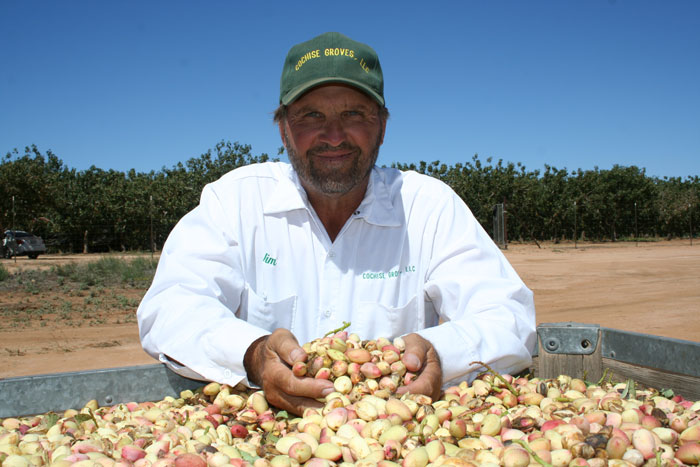August 5, 2015

In late July, Arizona pistachio grower Jim Graham kept one eye peeled on his nut trees while the other busily scanned the horizon for dark clouds and a summer monsoonal rain.
Two inches of rain fell days earlier – the first rain in five months on Jim and Ruth Graham’s Cochise Groves farm.
The 160-acre pistachio operation in Cochise (Cochise County) is nestled at the base of the Gunnison Hills and the Dragoon Mountains along the western edge of the Sulphur Springs Valley in southeastern-most Arizona.
“2015 has included the best growing conditions we’ve had in quite a few years,” Graham said.
In the early 1980s, the Kerman-variety orchards were planted by Ruth’s parents – Victor and Hazel Nilsen.
The farm sits on a 4,300-foot-elevation perch about 75 miles east of Tucson near Interstate 10 and about 60 miles from the Arizona-New Mexico state line.
“The pistachio nut quality looks terrific. It looks like a good crop,” Graham said somewhat cautiously, aware that monsoonal storms are a concern until the “rainy season” ends, usually in mid-September.
“It’s not over until it’s over,” he said.
The pistachio trees on the Graham operation are alternate bearing. 2015 is the higher yielding “on year.” He says it’s too early to guestimate yield, but he plans to double shake the trees at harvest.
Graham is somewhat surprised by the good crop, following a winter with milder temperatures and fewer chilling hours.
“We had a frost scare in April, but thankfully no damage occurred,” he said. “The trees pollinated well in the spring, and the crop has developed well this season.”
The farm is irrigated with groundwater drawn from 500-feet-deep wells. Water is pulled from about 300-feet down.
Rains have been few and far between this year. A 2.5-inch, three-day “soaker” in February was followed by five months of sunny skies. Monsoon moisture is needed to recharge the groundwater basin.
Pest and disease issues are usually uncommon at this dry, high-desert location. The fungus Septoria leaf spot, indigenous to Arizona, sometimes occurs.
According to New Mexico State University, signs of Septoria leaf spot include angular to circular, brown, necrotic lesions from 1-2 millimeters in diameter. Spots can merge and slightly increase in size.
Large parts of the leaf become necrotic and turn a light tan color. Black fungal fruiting bodies develop in the center of the lesion.
Graham’s Septoria leaf spot management plan typically includes four fungicide applications about three weeks apart from mid-June through August. The fungicides include Pristine, Quash (twice), and Bravo.
The disease, Phoma fungicola, was reported in pistachio in Cochise County in September 2012, according to an abstract written by S.F. Chen, D.P. Morgan, and Themis J. Michailides in the Journal of Plant Pathology.
The abstract says cankers on branches and blighted fruit of pistachio trees were observed in Arizona which caused infected fruit to become dark brown to black, covered by small pycnidia, and rachises were dried up.
Graham found the disease at high levels in his orchards in 2013, yet there has been little Phoma this year.
A fungicide trial for Phoma control is underway at Cochise Groves with the assistance of Themis Michailides of the University of California, Josh Sherman of the University of Arizona, Steve Fenn of Fertizona, and Todd Burkdoll of Valent.
Harvest at Cochise Groves typically starts in late August to early September and runs about six weeks.
Graham’s main pistachio processor is the Pistachio Corporation of Arizona located in Bowie. Meridian Nut Growers markets the nuts.
In addition to pistachios, the Grahams also grow 26 acres of wine grapes under the farm moniker Golden Rule Vineyards.
The varietals include Sangiovese, Syrah, Zinfandel, Cabernet Sauvignon, Petite Sirah, Grenache, Mourvédre, Cabernet Franc, and Petit Verdot.
You May Also Like




